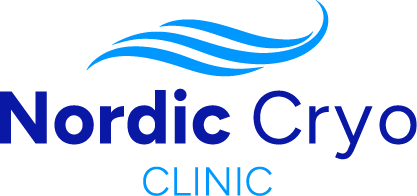Information regarding participation in Cryotreatment of the nose
The purpose of the procedure is to lift the conchae inferior (the lower concha of the nose) to create better air passage and to freeze the nerve at the back of the nose that is responsible for nasal secretion.
Before arriving at the clinic:
About an hour before arriving at the clinic, you must take painkillers in the form of over-the-counter medicine, 1 gram of Panodil/Pamol and 2 tablets of Ipren 200 mg (i.e. a total of 400 mg).
How is the procedure performed?
First, the doctor looks in your nose, and a spray is injected into your nose with local anaesthetic. The nose is then examined with a scope, and cotton wool with local anesthetic is placed on both sides of the nose, which may be associated with slight discomfort. The cotton wool is removed again after approx. 10 minutes In the cryo procedure, 2-3 places on the lower conch bone on both sides of the nose are frozen, if space permits. Each freeze is of approx. 45 seconds duration, i.e. a total of 3-4.5 minutes of freezing. The freezing procedure is not associated with major pain, but a certain discomfort in connection with the procedure cannot be ruled out, in the form of slight pain in the nose, teeth and cheek. It will also be possible to experience a pinching/freezing sensation in the nose. When the freezing is over, the doctor will clean the nasal cavity with suction.
After the procedure, you will find that the mucous membrane in the nose swells a lot and completely blocks the passage of air through the nose; this is completely to be expected. You may experience a headache and pain in the nose after the procedure. After the procedure, you will be given a saline nasal spray, which you can give 1-2 puffs of in each nostril morning and evening for 1-2 weeks or as long as you feel blocked in the nose. In addition, you will be given a nasal spray with adrenal cortex hormone which you can also take 1-2 puffs of in each nostril morning and evening for 1-2 weeks or as long as you feel blocked in the nose. You will need to blow your nose a lot after the procedure, but do not blow your nose too vigorously, as your nasal mucosa is more vulnerable during the recovery period after the procedure.
If, despite the above, you are still bothered by dryness or crusts in your nose, you can buy a nasal spray with sesame oil at the pharmacy, unless you have a known allergy to sesame oil. Sesame oil nasal spray is used with 1-3 puffs in each nostril for a maximum of 3 times a day.
For all nasal sprays, they must not be rubbed against the nasal septum when applying, as this can cause bleeding. In case of possible bleeding, put a little moistened cotton wool in the nose and press with the index finger and thumb on each side of the nose for 5-10 minutes. If you can supplement with ice in the mouth, which is pressed up against the palate with the tongue, this will stop the vast majority of bleeding. If you are taking blood thinners/fish oil and cannot stop the bleeding with the above procedure, you must call 1813, and in case of very heavy bleeding 112.
You will be given time in the clinic 7-10 days after the procedure to clean the nasal cavity with suction by a doctor. The full effect of the treatment occurs after 2-6 weeks. You must complete Sino-Nasal Outcome Test 22 questionnaire before the treatment and 6 weeks after the treatment and submit it in connection with the subsequent medical check-up.
Possible complications and side effects:
According to the literature in the field, no severe side effects have been reported in connection with the intervention. There may be a risk of adhesion formation (scar tissue formation) in the nose, but according to our experience and according to results in international studies, this has not been reported with cryotreatment. You can risk pain in the nose (tightening and freezing sensation) and headache during and immediately after the procedure and can take painkillers if needed, e.g. Tbl Paracetamol 1 gram maximum 4 times a day, possibly supplemented with tablet Ipren 200 mg 1-2 tablets maximum 3 times a day. However, you must not take Ipren if you have stomach ulcers, heart failure, severe high blood pressure, a severe lack of platelets in the blood or a hypersensitivity reaction/asthma attack triggered by an allergy to NSAIDs. There will also be a small risk of bleeding and infection during the procedure. You will certainly have a blocked nose in the weeks after the procedure and experience increased secretion from the nose.
In case of nosebleeds, high fever or severe pain, the clinic can be contacted on tel. 45 53 50 74 04. Outside the clinic’s opening hours, you must contact 1813 or possibly 112 in emergency cases.
We hope that 2-6 weeks after the procedure you will experience an improvement in air exchange through the nose and less secretion from the nose that will last for up to a year or more, but neither the degree of this nor the duration can be guaranteed.
Here you will find the clinic’s contact information:

